Morphofunctional charactersitics of strongest qualified swimmers aged 11-18
Фотографии:
ˑ:
Introduction. In the contemporary conditions of elite sport allocation of the most gifted and perspective athletes is of special importance, since record achievements are specific for athletes with the most optimal characteristics for the given sport. On the one hand, athletes differ by their morphological, functional and psychological characteristics, adapt differently to various work conditions and, on the other hand, targeted activity affects selection of the most gifted athletes and formation of their specific morphofunctional status [3].
Body build characteristics take one of the main places among the indices determining success of performance in swimming, that are taken into account at sport qualification at different phases of the long-term training; the choice of the method and swimming distance.
The purpose of the present study was to analyze morphofunctional characteristics of elite swimmers and work recommendations for correction of the training process.
Materials and methods. In 2010 Russian swimming federation adopted the program “I shall be a champion”, so the studies of the most perspective Russian swimmers within qualification to the country’s national team were held based on the club “Volga” in Volgograd. 11-18-year-old athletes, who took part in the qualification to the national team in 2010-2012, were the subjects of the examination. 11 examinations were held according to the full anthropological program, along with tests of the most perspective swimmers of Russia, who had taken part in Russian championships in Volgograd, upon trainers’ request. The total of examined athletes was 418 males and females.
The integrated study included anthropometric measurements [1], analysis of body weight components [5], physiological age [54], the morphofunctional condition of swimmers was estimated using special scales to determine the morphofunctional suitability of 11-18-year-old boys and girls for swimming classes in accordance with the technology [2].
The indices analyzed were as follows: total body sizes, longitudinal, cross-sectional and circumference indices, body proportions, indices of components of body weight composition, physiological age, levels of morphological state and indices of competitive activity (60 characteristics in total).
Results and discussion. When comparing the indices of training experience boys were proved to have the longest experience in the group of 16-year-olds – 10,1±6,19 years, the shortest – in the group of 13-year-olds – 5,50±0,88 years. Girls had a similar tendency: the longest experience – in 16-year-olds – 7,38±1,34, the shortest – in 11-year-olds– 4,85±1,76. The differences between girls are unreliable (р>0,05). As for boys, the difference is reliable between 17- and 18-year-old swimmers (р <0,05).
The analysis of the key parameters of total body sizes of male and female athletes aged 11-18, who participated in the qualification to the national team, is presented in Fig. 1, 2.
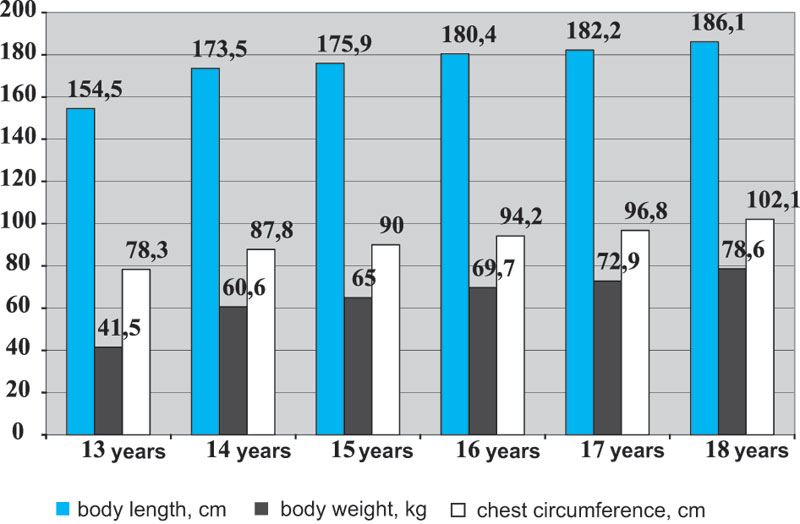
Fig. 1. Indices of body length (cm) and weight (kg), chest circumference (cm) of the strongest swimmers aged 13-18
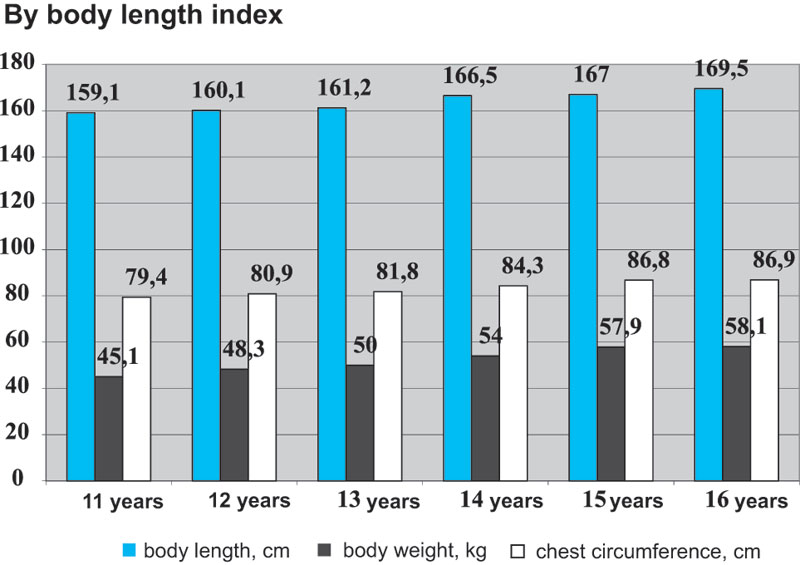
Fig. 2. Indices of body length (cm) and weight (kg), chest circumference (cm) of the strongest qualified female swimmers aged 11-16
The comparison of these indices revealed that the highest body length indices were marked among female athletes aged 16 and 18 (169,5±5,66-186,1±5,42), the lowest – in female athletes aged 11 and male athletes aged 13 (159,1±6,93 and 154,5±6,93), i.e. among swimmers from junior age groups. The differences in the body length index are significant between female athletes aged 13 and 14, 15 and 16 (р <0,05), male athletes aged 13 and 14 (р <0,001), 14 and 15, 15 and 16 and 18 (р <0,05).
The biggest body weight is inherent in girls and boys aged 16 and 18 respectively (58,1±4,88 and 78,6±4,44), the smallest – in girls aged 11 and boys aged 13 (45,1±7,26-41,6±3,72). The differences in body weight are reliable among girls between 11 and 12, 13 and 14, 14 and 15 years (р <0,05). As for boys - between 13 and 14, 14 and 15, 15 and 16, 16 and 17, 17 and 18 years (from р<0,05 to р <0,001).
The same trend is observed in chest circumference: the highest values belong to girls and boys aged 16 and 18 respectively (86,9±2,53 and 102,1±2,02), the lowest – to girls and boys aged 11 and 13 respectively (79,4±4,49 and 78,3±0,44). The differences are reliable between female athletes aged 13 and 14, 14 and 15 (р <0,05). As for boys – between 13 and 14, 14 and 15, 15 and 16, 16 and 17, 17 and 18 years (from р<0,05 to р<0,001).
The largest absolute body surface is specific for female and male athletes aged 16 and 18 respectively (1,68±0,11 and 2,05±0,25), the smallest – for girls and boys aged 11 and 13 respectively (1,44±0,13 and 1,36±0,07). The differences are reliable between female athletes aged 11 and 12, 12 and 13, 13 and 14, 14 and 15, 15 and 16 (р <0,05). Regarding boys – between 13 and 14, 14 and 15, 15 and 16, 16 and 17, 17 and 18 years (р <0,001 and р<0,05 ).
The results of the analysis of the primary components of body weight composition of the strongest male and female swimmers aged 11-18 are adduced in Fig. 3-4.
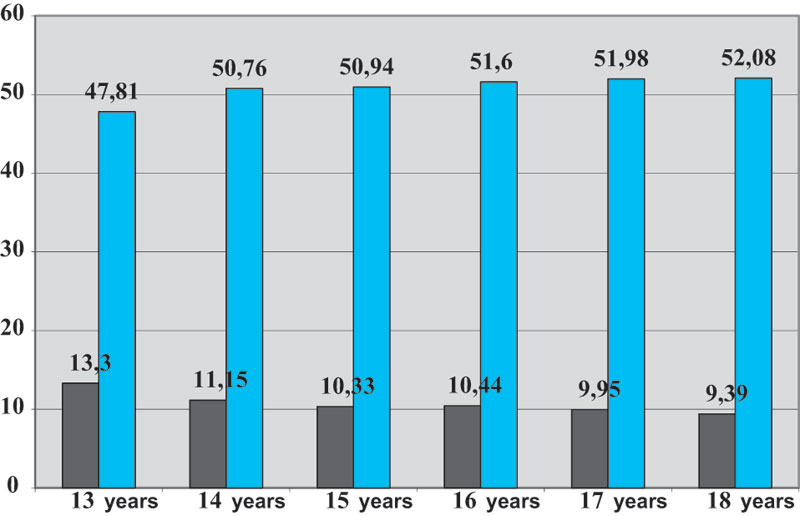
Fig. 3. Indices of relative fat and relative muscle masses of the strongest qualified swimmers aged 13-18, %
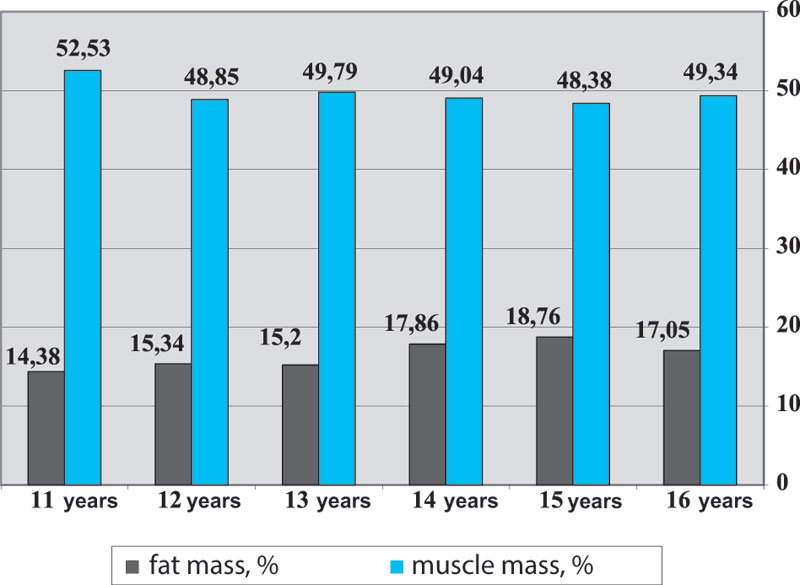
Fig. 4. Indices of relative fat and relative muscle masses of the strongest qualified swimmers aged 11-16, %
The lowest values of absolute (kg) fat mass belong to female athletes aged 11 and athletes aged 13 (7,11±3,07 and 6,03±2,03), the highest – female athletes aged 15 and male athletes aged 17 (10,94±4,52 and 7,69±1,62). Female athletes aged 11 and male athletes aged 12 (14,38±3,58 and 6,03±2,03) have the lowest values of relative fat mass.
The differences are reliable in the index of absolute fat mass (kg) between female athletes aged 14 and 15 (р<0,05), in relative fat mass (%) between female athletes aged 13 and 14, 14 and 15 (р<0,05).
The highest indices of absolute muscle mass (kg) were marked in female athletes aged 16, male athletes aged 18 (28,68±3,20 and 40,95±3,35), the lowest – in female athletes aged 11 and male athletes aged 13 (21,92±3,78 and 19,90±2,16).
The highest indices of relative muscle mass were found in female athletes aged 11, due to insufficient sample of athletes aged 18 (52,53±0,66 and 52,08±2,12).
The differences are reliable in the index of absolute muscle mass (kg) between female athletes aged 11 and 12 (р<0,05); female athletes aged 13 and 14, 14 and 15, 15 and 16, 16 and 17, 17 and 18 (from р<0,05 to р<0,001), and in the index of relative muscle mass - between female athletes aged 11 and 12 (р<0,05); athletes aged 13 and 14 (р<0,05).
The largest values of vital capacity (ml) are marked in female athletes aged 16 and male athletes aged 18 (3466,7±471,4 and 5556,1±841,8), – in female athletes aged 11 and male athletes aged 13 (2679,0±558,1-2900,0±530,9). The differences are reliable between athletes aged 13 and 14, 17 and 18 (р<0,05).
The highest indices of fingers and hand dynamometry (kg) of the right hand were marked in female athletes aged 16 and female athletes aged 18 (26,6±3,70 and 52,9±9,09), the lowest – in female athletes aged 11 and male athletes aged 13 (9,0±1,77 and 16,5±2,65). The differences are reliable between female athletes aged 11 and 12, 14 and 15 (р<0,05); male athletes aged 13 and 14, 14 and 15, 15 and 16, 16 and 17, 17 and 18 (from р<0,05 to р <0,001).
The highest indices of fingers and hand dynamometry (kg) of the left hand are observed in female athletes aged 16 and male athletes aged 18 (24,1±3,03 and 46,9±8,42), the lowest – in female athletes aged 11 and male athletes aged 13 (6,5±2,65 and 13,0±0,26). The differences are reliable between female athletes aged 11 and 12 (р <0,001), 12 and 13, 13 and 14, 15 and 16 (р <0,05); between male athletes aged 13 and 14 (р <0,001), 14 and 15, 15 and 16, 17 and 18 (from р<0,05 to р <0,001).
The morphofunctional state of swimmers was estimated using special scales to determine morphofunctional suitability of boys and girls aged 11-18 for swimming classes by the technique of V.Yu. Davydov et al. [2].
The final estimate of the morphofunctional state was calculated as a mean score from the total estimates in all features of the scale.
Most of the studied athletes (Table) belonged to the average and above the average levels of morphological states – 27,51-63,87%, high - 7,18 % of contingent, and only 1,44 % of athletes – to the below the average level of morphological state. The cases of low morphological state were not registered.
Table. Morphofunctional states of 11-18-year old athletes of the junior swimming national team of Russia, %
|
Age, years |
n |
Groups |
low |
below the average |
average |
above the average |
high |
|
11 |
- |
boys |
- |
- |
- |
- |
- |
|
8 |
girls |
- |
- |
12,5 |
75,0 |
12,5 |
|
|
12 |
- |
boys |
- |
- |
- |
- |
- |
|
39 |
girls |
- |
- |
35,89 |
58,99 |
5,12 |
|
|
13 |
13 |
boys |
- |
11,76 |
17,66 |
58,82 |
11,76 |
|
17 |
girls |
- |
- |
29,41 |
58,82 |
11,77 |
|
|
14 |
85 |
boys |
- |
- |
17,64 |
78,82 |
3,54 |
|
41 |
girls |
- |
- |
29,26 |
56,09 |
14,65 |
|
|
15 |
64 |
boys |
- |
|
25,0 |
71,88 |
3,12 |
|
28 |
girls |
- |
- |
14,28 |
78,57 |
7,15 |
|
|
16 |
62 |
boys |
- |
1,62 |
35,48 |
48,38 |
14,52 |
|
22 |
girls |
- |
9,1 |
36,36 |
54,54 |
- |
|
|
17 |
26 |
boys |
- |
- |
38,46 |
57,69 |
3,85 |
|
- |
girls |
- |
- |
- |
- |
- |
|
|
18 |
13 |
boys |
- |
|
38,46 |
61,54 |
- |
|
- |
girls |
- |
- |
- |
- |
- |
|
|
∑ |
263 |
boys |
- |
1,14 |
27,0 |
65,40 |
6,46 |
|
∑ |
155 |
girls |
- |
1,95 |
28,38 |
61,29 |
8,38 |
|
∑ |
418 |
(common) |
- |
1,44 |
27,51 |
63,87 |
7,18 |
The analysis of sexual dimorphism of the morphofunctional state of female athletes revealed 1,14% of athletes with the morphofunctional state below the average, 28,38% - average, 61,29 % - above the average, 8,38% - high. Boys have the dominating morphofunctional states above the average and high – 65,49 and 6,46%. The average morphofunctional state was marked in 27,0% and below the average – in 1,14%.
According to the analysis of the tested contingent in respect to type of development, 52,94 % of the engaged with retarded development prevail in these age groups. 33,20% of male and female athletes were proved to be with normal (average) type of development and 13,88% with accelerated type of development (Fig. 2-3).
Proceeding from the analysis of sexual dimorphism of types of development, girls with retarded development amount to 62,93%, normal – 29,32% and accelerated – 7,76%. Male swimmers with retarded development amount to 45,58%, normal – 36,07% and accelerated – 18,35%.
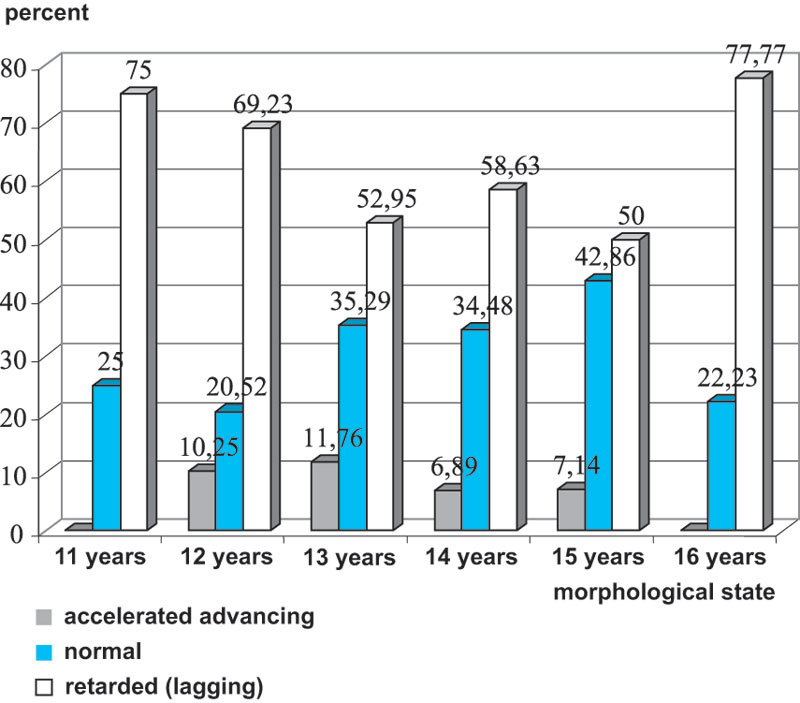
Fig. 5. Types of development of the strongest qualified swimmers aged 11-16, %
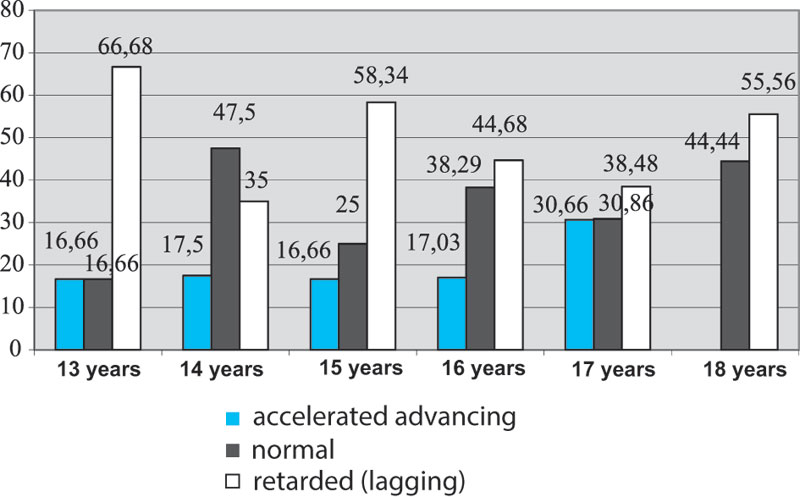
Fig. 6. Types of development of the strongest qualified swimmers aged 13-18, %
The performance of a big group of athletes, who have gone through tests in Volgograd at different phases of training within the program “I shall be a champion”, was a success at the 11th European Junior Olympic festival in Trabzon, Turkey – in July 2011 they won the total of 23 medals and the first team place: 12 gold, 8 silver and 3 bronze medals.
The athletes of happiness were Marina Baklakova: 5 gold and 1 silver medals; Marina Guzhenkova won 2 gold and 1 silver; Anna Ganus – 2 gold, 1 silver; Daria Ustinova – 2 gold and 1 bronze.
As for boys the most successful were: Semen Makovich – 2 gold and 1 silver; Evgeny Sedov – 3 gold and 1 silver and many others. At the Junior World Championship the achievements of our athletes were significantly lower – 1 silver and 3 bronze medals, and Irina Novikova won 3 bronze medals.
At the 39th European Championship among juniors aged 15-16, held in Antwerp (Belgium) in 2012, our team won 21 medal – 12 gold, 6 silver, 3 bronze and took the first team place. And again the same athletes were the most remarkable in their performance.
Usually, most of these athletes belong to the above the average, high and average (some athletes) states by the morphological type.
Conclusion.
1. The carried out study provides for assessment of the level of morphofunctional development of junior male reserve in swimming and giving practical recommendation to trainers regarding individual correction of the training process.
2. There were established the parameters of total, longitudinal and circumference body measures, indices of the components of the body mass composition and functional indices of the strongest qualified athletes aged 11-18.
3. 27,51 and 63,87% were proved to belong to the average and above the average level of morphological state, 7,18% of the contingent - high, and only 1,44% of male and female swimmers belong to the below the average morphological state. Low morphological states were not revealed.
4. According to the studies, 52,94% male and female swimmers with retarded development prevail in the examined age groups, 33,20% – with normal (average) type, athletes of the accelerated type of development total to 13,88%.
5. Considering morphofunctional characteristics of development of the body and the pubertal growth stage ensures necessary amendments in the advanced planning to realize athlete’s potential in the long-term aspect of training.
References
- Bunak, V.A. Anthropometry / V.A. Bunak. – Moscow: Uchpedgiz, 1941. – 250 P (In Russian)
- Davydov, V.Yu. Morphological selection criteria and control in swimming /V.Yu. Davydov, V.S. Bakulin, V.I. Savvin et al. – Volgograd: VSAPC, 1995. – 18 P. (In Russian)
- Martirosov, E.G. Human morphological status in extreme conditions of sports activity / E.G. Martirosov // The results of science and technology: Anthropology, V. 1. – Moscow, 1985. – P 100–153. (In Russian)
- Timakova, T.S. Characteristics of biological development and sports result in swimming / T.S. Timakova, A.F. Shubabko // Swimming: Anthology. – Moscow: Fizkultura i sport, 1980. – Вып. – P. 40–44. (In Russian)
- Matiegka J. The testing of physical efficiency / J. Matiegka // Amer. Journal of Physiol. Antropol. – 1921. – V. 4. – P. 133–230.
Author’s contacts: v-davydov55@list.ru

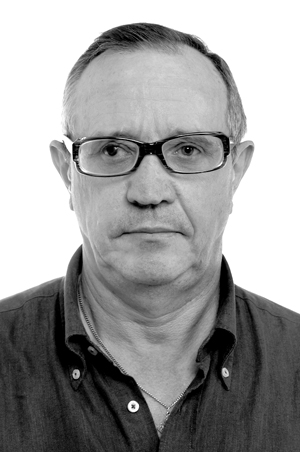

 Журнал "THEORY AND PRACTICE
Журнал "THEORY AND PRACTICE